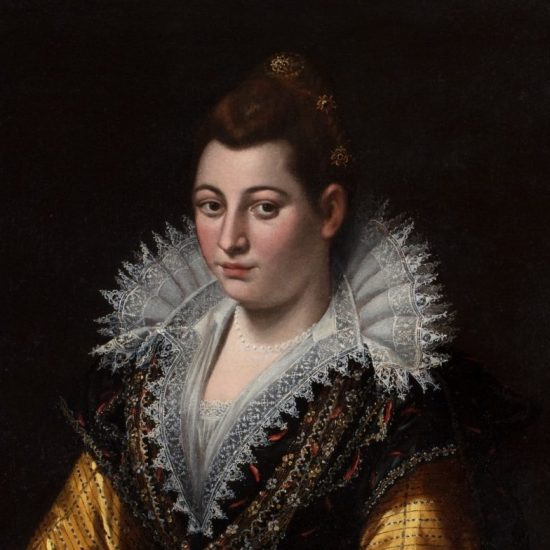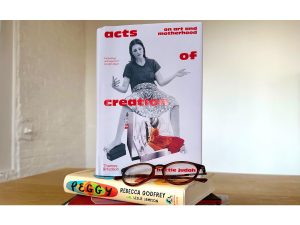
Possibly because of the absence of a string of nucleotides in chromosome 8, fewer than one in a billion people have a hereditary condition known as generalized hypertrichosis terminalis, which leads to a covering of fur over most of their body. Historically, most of those who’ve had hypertrichosis worked in exhibitions and zoos, carnivals and geek shows. Turn-of-the-century performers such as Stephan Bibrowski (“Lionel the Lion-faced Man”), Krao Farini (“The Missing Link”), and most famously Fedor Jeftichew (“Jo-Jo the Dog-Faced Boy”) were forced into dehumanizing performances, their stage names indicative of the cruel culture of spectacle that has so-often maligned those who physically don’t conform to an arbitrary ideal of beauty. Before all of those figures, there was Pedro Gonzalez, the first to be identified with the condition, born among the Indigenous Guanche people of the Canary Islands in the 16th century.
Brought to the court of King Henry II of France to be enslaved as the monarch’s pet, Gonzalez was described as a canine, a simian, and a bestial half-man. When courtiers realized that Gonzalez was not only fluent in French and Spanish, but Latin as well, he was dressed in aristocratic finery and mockingly treated as titled, a beast-man made to pantomime nobility. Despite their supposed physical irreconcilability, Gonzalez and his wife seemed to have had a happy union resulting in seven children, though four of their progeny inherited hypertrichosis and were treated as inhumanely as he was. A representative example would be the inscription on a portrait of Gonzalez’s daughter Antonietta for Italian naturalist Ulisse Aldrovandi’s Monstrorum Historia (1642) — or “The History of Monsters” — that reads “A hairy woman of twenty whose head resembles that of a monkey.”
A different sentiment is expressed in a 1595 composition exhibited at the Museum of Fine Arts at the Site Château de Blois. Rendered when the Gonzalez family was in Parma, the portrait presents young Antonietta in a manner befitting the noble dress in which she is clothed. Around 10 years old at the time of the sitting, she wears finely embroidered cloth decorated with intricate designs in red, blue, and gold thread; her lips are ruby-red and her russet eyes are clear, bright, and curious; a feathered tiara is subtly seen rising about the crown of her striking strawberry blonde hair. That hue was from her mother, but she has the same tell-tale hirsutism of her father, the same thick and shaggy hair covering her face.

Here, Antonietta is not meant to be a monster, but rather a girl, a child, a human. Not only that, but Antonietta Gonzalez is pretty. The letter she clutches in her portrait announces her in a dignified manner as a member of the “court of the Lady Isabella Pallavicina, the honorable Marchesa of Soragna.” That most remarkable portrait of the Italian late Renaissance was produced by one of that period’s most remarkable artists — Lavinia Fontana, the first woman to make a living based on artistic commissions. It’s a fallacy of naïve sentimentalism at best and gender essentialism at worst to assume that the empathy expressed in “Portrait of Antonietta Gonzalez” is because it was painted by a woman, but it’s natural to ponder whether Fontana saw something of herself in her subject, a person reduced to a wonder by the arbitrary strictures of an unjust and unequal society.

Fontana was among the most respected Mannerist painters in Italy. Favored for the stunning verisimilitude in her technique, she became the most important early woman painter to develop a reputation for genius. Daughter of a prominent Bolognese painter, Fontana married one of her father’s pupils, an artist understood to be far less talented than she — both now and then — who acted as her agent. Even the marriage contract stipulated that in lieu of a dowry, Fontana would support herself through her work. Success during her life has only been surpassed by modern acclaim, as with the National Gallery of Ireland’s landmark 2023 exhibition of her work, or the sale of “Portrait of Antonietta Gonzalez,” which at auction that same year fetched well over a million dollars.
More than Fontana’s biography, interesting though it may be, is the matter of her art. In Stephen Greenblatt’s 1980 Renaissance Self-Fashioning: From More to Shakespeare, Greenblatt describes the eponymous process as a means of individuation that emerges from humanist discourses of the period, whereby his (exclusively male) examples used literature, philosophy, and art to construct a “distinctive personality, a characteristic address to the world, a consistent mode of perceiving and behaving.” As a portraitist, Fontana was concerned with that process; as a portraitist celebrated for her naturalistic renderings of women, she generated a distinctly feminine form of Renaissance self-fashioning.
Fontana’s talent in that regard isn’t just obvious as a matter of prodigious technique, but in the more subtle commitments of her work as well. Part of what’s so arresting about “Portrait of Antonietta Gonzalez” is that her subject — already primed to be exploited — is conveyed without a hint of scopophilia. To the contrary, Antonietta appears inquisitive, happy, and self-assured. This is no picture for a wonder cabinet or freak show: It is a portrait that gazes back. Though her other subjects may have lacked the innate eccentricity of Antonietta, that process of feminine self-fashioning is apparent across the small number of Fontana’s portraits that survive. Comparing the artist to past generations of Bolognese painters, critic Caroline P. Murphy notes in Lavinia Fontana: A Painter and her Patrons in Sixteenth-century Bologna (2003) that she was “able to convey an intimacy and a psychological connection between her subject and the viewer that that are lacking in the older artists’ work.” That she was among the most in-demand portraitists of the Bolognese aristocracy — perhaps in part so they wouldn’t have to suffer predatory male artists — demonstrates Murphy’s point.



In her c. 1595 portrait of Ritratto di Costanza Alidosi, held by Washington DC’s National Museum of Women in the Arts, Alidosi wears an elaborate black-and-gold brocaded dress, staring out at the viewer with a keen gaze. The countess’s right hand grips the red velvet of her chair with tensed muscle, her stern, unsmiling face suggesting a person charged with power and responsibility. The only sop to softness is the tiny dog she holds on her lap.
Tiny spaniels are nearly omnipresent in Fontana’s portraits of noblewomen, perhaps to soften the austere authority otherwise conveyed. A brown-and-white dog is just to the far left of the Walters Art Museum in Baltimore’s “Portrait of Ginevra Aldrovandi Hercolani” (c. 1595), suggesting a depth of character that transcends the imperious atmosphere of a composition textured by the appearance of dark, heavy velvet and deep abiding shadow and punctured by the withering gaze of its subject. An even more striking group portrait is “Bianca degli Utili Maselli and Six of Her Children” (c. 1604–5) held by the Fine Arts Museum of San Francisco. The composition is centered by another matron with an authoritative gaze, framed by children whose physical resemblance is obvious. She drapes an arm over her daughter, who in turn clutches her finger. But, bedecked in resplendent black and orange finery, Maselli emanates a familial power that is more monarchical than maternal.


Fontana didn’t constrain her practice to noblewomen and their families; rather, she was a popular painter of Counter-Reformation altars. Indeed, she may have been one of the very first women to represent that most iconic woman in Western culture, the Virgin Mary. Her 1593 altar for the Collegiata di Santa Maria Maggiore shows a mystic Virgin ascending upward surrounded by a veritable chorus of cherubim, pudgy infants all. “Assumption of the Virgin,” painted ten years before, is imbued with an empathy of a fellow mother: Two male priests in golden stoles on bent knee pray towards a glowing heaven in which Mary is surrounded again by cherubim, a paradise only for women and children. Then there is Fontana’s harrowing version of “Judith and Holofernes” (1600), a popular narrative for Italian painters of the time. Less famous than Artemesia Gentileschi’s version — though the younger woman was heavily indebted to Fontana — this version chooses to cast its glow on Judith, the decapitated head of Holofernes consigned to a sack at the side. Not a censorship of gore, but rather a centering of the heroine, a radical feminine self-fashioning in one of Fontana’s most autobiographical of compositions.
A 1579 self-portrait tells of the process behind such works: In the painting now held at the Uffizi, Fontana sketches in a study that evokes the libraries of men like Montaigne or Erasmus, a room where she is surrounded by small gray models of classical statues stored on brown shelves. In royal purple with a heavy crucifix about her neck, the artist seems to look up for a minute — only a minute — to match the gaze of the viewer, before returning to the work she has at hand.





